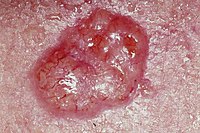
Photo from wikipedia
BACKGROUND The aim of the present study was to compare repeated applications of antimicrobial photodynamic therapy (aPDT) to open flap debridement (OFD) in the treatment of residual periodontal pockets in… Click to show full abstract
BACKGROUND The aim of the present study was to compare repeated applications of antimicrobial photodynamic therapy (aPDT) to open flap debridement (OFD) in the treatment of residual periodontal pockets in non-furcation sites. METHODS Forty-six subjects with a diagnosis of Stage III or IV Grade C periodontitis, that had been previously treated, participated in the study. Residual pockets were divided between two groups: 1) aPDT group: received ultrasonic periodontal debridement followed by immediate application of aPDT, and repeated on1st, 2nd, 7th and 14th days; and 2) OFD group: treated by modified papilla preservation technique, where granulation tissue and visible calculus were removed with hand curettes and an ultrasonic device. Clinical, immunological and microbiological parameters were evaluated before and after treatment. RESULTS Both treatments were effective reducing clinical parameters of disease. OFD resulted in a greater mean probing pocket depths (PPD) reduction in deep pockets (p = 0.001). However, aPDT resulted in a lower occurrence of gingival recession (GR), dentin hypersensitivity and analgesic intake. Reduction in Porphyromonas gingivalis was observed in both groups. Only the OFD group had a significant reduction in Aggregatibacter actinomycetemcomitans. aPDT group had greater increase in IL-10 levels and a greater reduction of IL-1β at 14 days when compared to the OFD group (p<0.05). CONCLUSION OFD was superior in reducing PPD in deep pockets compared to the aPDT. However, OFD resulted in greater GR. Both treatments lowered P. gingivalis levels but only OFD reduced levels of A. actinomycemtemcomitans. This article is protected by copyright. All rights reserved.
Journal Title: Journal of periodontology
Year Published: 2022
Link to full text (if available)
Share on Social Media: Sign Up to like & get
recommendations!